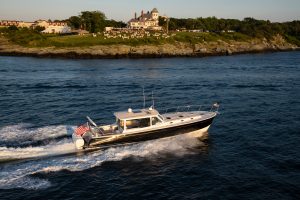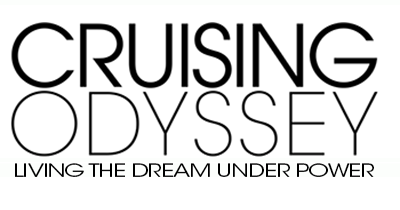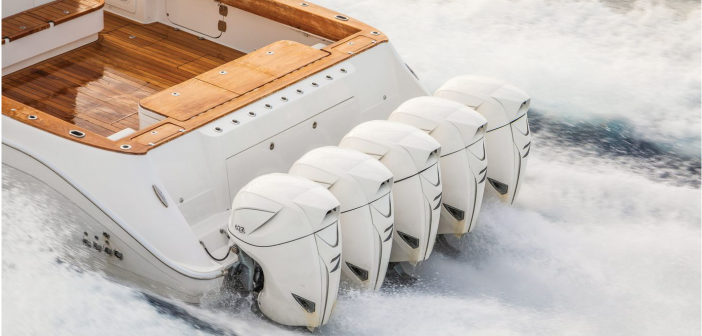Perhaps the strongest trend in recent years has been the rapid growth of outboard power on cruising boats, even on some of the most traditional brands. The reasons are easy to understand, and they start with performance. Outboard boats are fun, they’re fast and agile, and they’re easy to drive and park.
Outboards also are easier to repair, maintain, and ultimately replace, if necessary, than traditional inboards are, and they open up a lot of space inside the boat where inboards used to be. And you don’t have to worry about a lot of through-hulls, shafts, and struts.
The HCB 65 Estrella (pictured above) is powered by five 627-hp Seven Marine outboards, producing 3,135 hp. That may be a bit more than what most of us need, but it shows what’s possible.
Here’s a look at four new outboard-powered boats that we’ve covered lately, ranging from a luxury yacht to a pocket cruiser:
MJM 53Z

I certainly had expected to enjoy the new long, low, elegant MJM 53z, with its four 400-hp Mercury Verado outboards. After all, I’d already driven its predecessor, the MJM 50z, with three 435-hp Volvo IPS600 pod drives, as well as every other MJM model. But once I got behind the wheel of the 53z I realized it was even better – and a lot more fun – than I had anticipated.
One of the main reasons outboards have become so popular lately, is that they simply provide more head-turning acceleration than is possible on most inboards; they carve turns faster, and, as many people have noted, driving an outboard is similar to driving a sports car.
All that is true on the MJM 53z. But what’s different is that the MJM 53z is a luxurious yacht, with two full cabins (with easy chairs), two large heads, a galley that would do justice to many a New York studio apartment, plus an enclosed helm deck that’s essentially an extra salon up top, and a large aft deck/cockpit.
On an early summer morning, before I climbed on the boat, I looked at it across the dock at the Newport Shipyard in Rhode Island and realized that this Doug Zurn-designed beauty with its glistening black hull and gold stripe was a big yacht. The four white outboards made it look even larger.
And they delivered. We hit a top speed of 51 knots this morning; the 50z had topped out at 38.7 knots when I had driven it earlier in Long Island Sound.
The point was that this was not a 30-foot sportboat. It was a full-fledged 53-foot ocean-going yacht equipped with everything you’d need for a week or longer cruise to Maine or the Bahamas (including the standard Seakeeper gyro stabilizer). And you’d be safe along the way. The MJM 53z has an ISO Category A Ocean Certification, attesting to its seaworthiness in some gnarly conditions. http://mjmyachts.com
HINCKLEY SPORT BOAT 40X

This isn’t a surprise, but the Hinckley Sport Boat 40X, the cruising version of the iconic Maine builder’s outboard boats, has just about everything right – the proportions, the flowing lines, the updated application of Hinckley’s Down East heritage.
The 40x is the second version of the outboard-powered sport boat that Hinckley introduced two years ago; ago; the first was more of a center console model, even though it had a cabin. But the 40x is a cruising boat with enough interior space for two couples or a family.
The boats are designed by the Ray Hunt team, the people who basically invented the modern deep-V hull for offshore performance, and they were built specifically for outboard engines. Both are powered by three 300-hp Mercury Verados, producing a top speed of 47 knots, although you can order two monster 627-hp Seven Marine outboards as options.
The bridge deck is fully protected by a hardtop and large side windows. A large L-shaped settee with a teak table is to port, across from a console with a sink, fridge and storage to starboard.
Below, a guest cabin is tucked under the helm with a berth for two set athwartships. The galley is to port and the head to starboard. Forward, a set of V-shaped settees and a raised teak table function as a social or dining area during the day; at night they convert to a double bed. A teak-and-holly sole add a nautical touch. http://hinckleysportboats.com
BACK COVE 309

The new Back Cove 390, due to be launched this fall, has the Maine builder’s traditional low profile, long sheer, and classic design. It embraces Back Cove’s easy-to-use and easy-to-enjoy cruising philosophy, which has made the brand, a sister company to Sabre Yachts, increasingly popular.
With three 350-hp Suzuki outboards, Back Cove is projecting a top speed of 37 knots and a range of 300-plus nm at cruising speeds for the 390. Other power options are being finalized that could push the top speed up to the 40-knot-plus range. The new boat features Back Cove’s proprietary Trailing Edge Lifting Surface hull for optimal handling and performance.
The 390 is built on the success of the Back Cove 340, the company’s first outboard-powered boat, which was named both the People’s Choice and the Best New Powerboat Under 35 Feet at the Newport, Rhode Island, boat show in 2018.
The helm deck of the 390 has a hard back, an unusual feature on a boat of this size, so the helm deck is totally protected and climate-controlled for year-round comfort. The galley is up, opposite a U-shaped settee.
You can watch TV in the lounge below. The owner’s cabin is forward with an island queen berth and private access to the head and shower. A guest cabin with two single berths is aft of the lounge. http://backcoveyachts.com
RANGER TUGS 27

Ranger Tugs introduced its R-27 with a single Yamaha F300 outboard two years ago, and the boat has become popular because it offers a lot to cruising comfort and amenities (Ranger trademarks) with a good turn of speed – more than 40 mph, in fact.
Over the years, I’ve cruised on Ranger Tugs in the San Juans and the Canadian Gulf Islands and have always enjoyed their comfort, creative use of space and easy living on board. With a standard bow thruster, and remote, the 27 is easy to handle around a dock, while the two-cabin, one-head layout makes cruising comfortable for a family or a small group of friends.
The forward cabin has a V-berth that sleeps two adults comfortably; the bed is more than 6’5” long, and the cabin has a head with shower. The salon includes a midship office space with a desk and a chair; it converts to a berth that sleeps two, while the dinette table is on a hydraulic piston and converts to a berth or lounge area. The signature Ranger Tugs curved windshield and overhead glass provide a lot of light for the salon. The standard galley includes a sink, fridge, inverter, microwave and combination propane stove/oven.
With its 8’6” beam and 7.000-pound weight, the Ranger 27 can be trailered easily from one cruising destination to another. The R-27, like all Rangers, comes fully equipped and ready to cruise. Base price: $199,937. http://rangertugs.com




